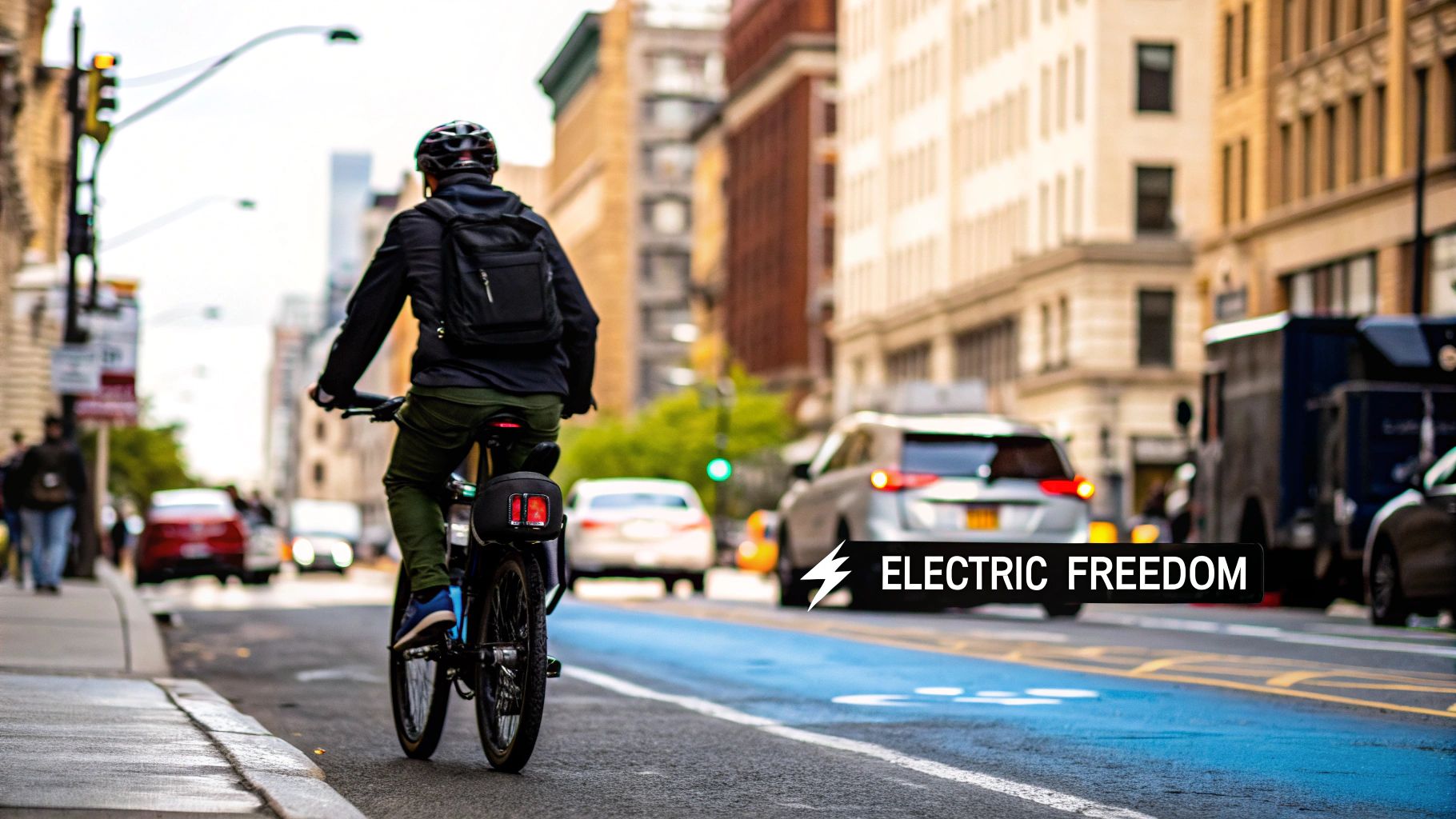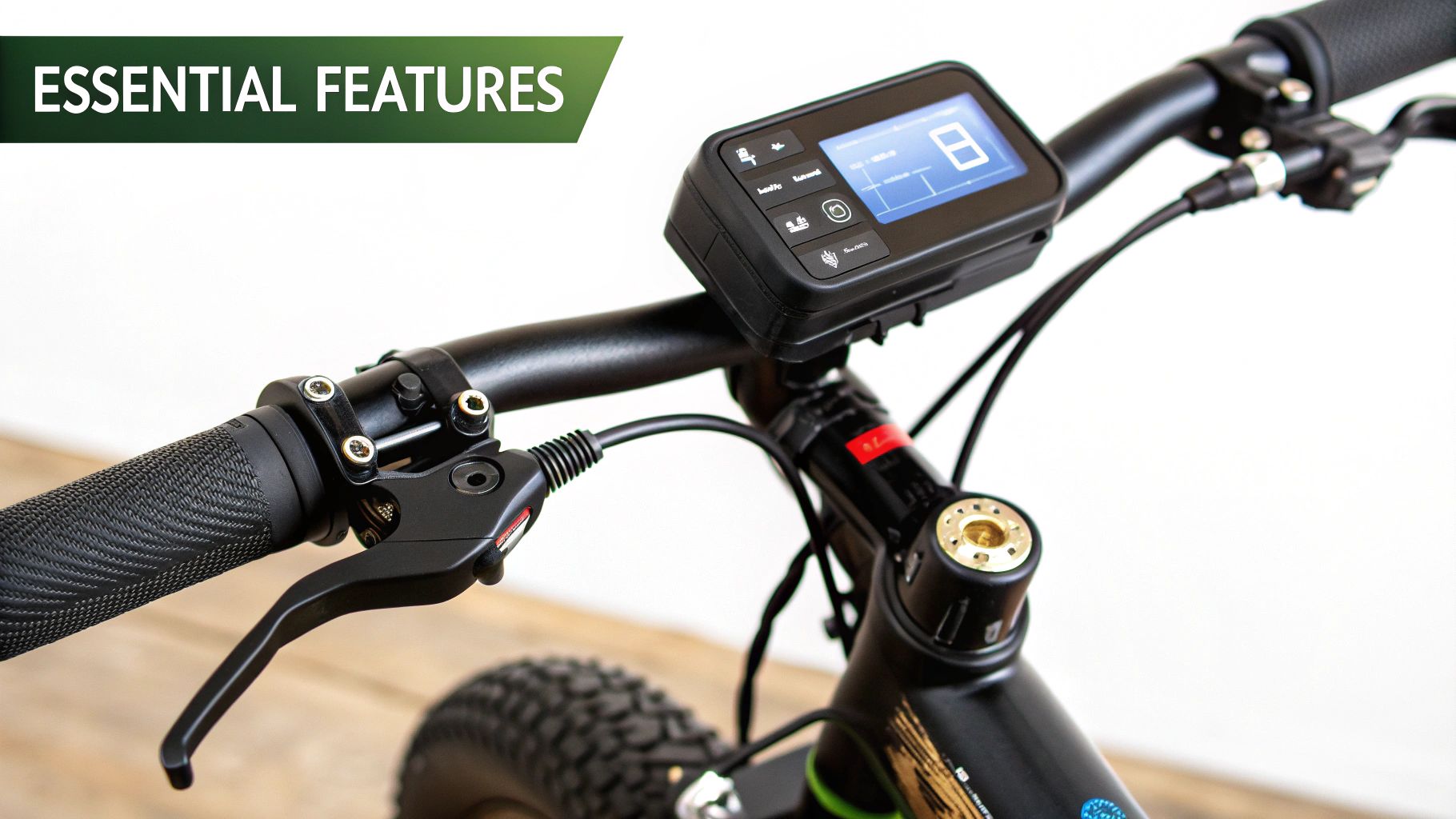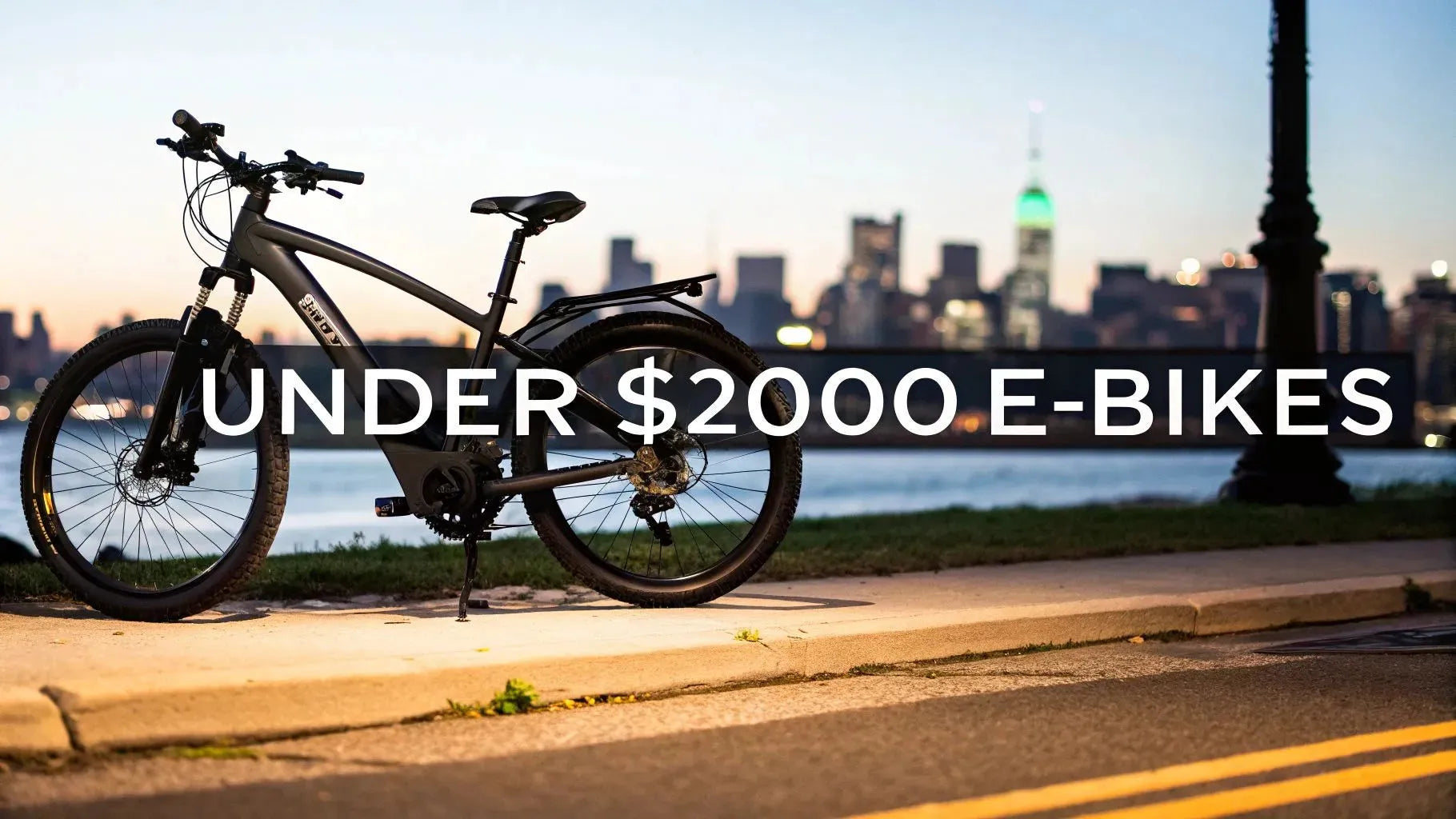Believe it or not, finding a fantastic electric bike under 2000 pounds is totally achievable. This price range is the magic number where affordability meets real-world performance, giving you tons of great options for your daily commute or weekend fun.
Why an E-Bike Under £2000 Is Such a Big Deal
Getting into the e-bike scene doesn't have to mean taking out a second mortgage. The market has exploded with awesome, budget-friendly options, so you can find a high-quality ride that won't break the bank. Think of this guide as your personal shopper, here to help you sort through the noise and find a bike that's a perfect mix of value and pure joy.
The e-bike world is blowing up—it's a massive £50 billion industry as of 2024. A huge slice of that pie comes from bikes in this sub-£2,000 sweet spot, especially in Europe and North America. To put it in perspective, nearly 47 million e-bikes were sold worldwide in 2023 alone, and a ton of those were affordable models built for everyday riders, commuters, and students. You can dive deeper into these market trends over at Grand View Research.

What to Expect from an E-Bike Under £2000
Here's a quick look at the features and performance you can realistically get for your money.
| Feature | Typical Specification Under £2000 | Why It Matters for Your Ride |
|---|---|---|
| Motor Power | 250W hub or mid-drive motor | Provides plenty of oomph to flatten hills and make your commute feel effortless, while staying road-legal in the UK & EU. |
| Battery Range | 40-80 km per charge (25-50 miles) | Enough juice for daily trips to work or school, plus some fun weekend rides. |
| Brakes | Mechanical or hydraulic disc brakes | Offers reliable stopping power in all weather, which is a huge safety upgrade from old-school rim brakes. |
| Gears | 7-speed (or more) from brands like Shimano | Gives you the flexibility to pedal comfortably, whether you're on a flat road or a steep hill. |
| Included Accessories | Mudguards, integrated lights, and a rear pannier rack | Saves you money on essential add-ons and makes the bike ready to ride right out of the box. |
This table gives you a solid baseline. At this price, you're investing in a machine built for daily reliability and a whole lot of fun—not just a basic frame with a motor tacked on.
Think of an e-bike under £2,000 as the perfect all-rounder. It’s like a trusty, do-it-all hatchback—it gets you where you need to go reliably and comfortably, without the sky-high price tag of a luxury sports car.
Figuring out the right personal electric vehicle can be a tough call. While this guide is all about e-bikes, you might find our comparison of electric scooters helpful to see which ride truly fits your lifestyle: https://www.punkride.com/blogs/news-advice/compare-electric-scooter
Ready? Let’s demystify the tech specs, check out some trustworthy brands, and break down the features that actually matter. It's time to find the e-bike that feels like it was made just for you.
How to Choose the Right E-Bike Motor
The motor is the heart and soul of your e-bike. It’s what gives you that awesome push when you’re pedalling, turning a tough ride into a joyride. When you're shopping for the best electric bike under 2000 pounds, you’ll mostly run into two kinds of motors: hub-drive and mid-drive. They feel completely different, so figuring out which one is for you is a huge part of loving your bike.
A hub-drive motor sits in the centre of either the front or rear wheel. The best way to describe the feeling is like getting a solid, consistent push from behind. It's awesome for cruising on flat roads and zipping around town. The power kicks in right away, so it’s perfect for getting a quick start at a traffic light.
On the other hand, a mid-drive motor is located down by the pedals in the bike's frame. Riding one feels like you've suddenly been gifted with bionic legs. It works directly with your bike's gears, so the power feels incredibly natural and intuitive. This setup is the undisputed king of hills because it uses the bike's own gearing to its advantage, making even the steepest climbs feel manageable.
Power vs. Torque: What Do The Numbers Mean?
As you compare bikes, you’ll see specs like watts (W) and Newton-metres (Nm). Don't let them intimidate you; they're pretty simple.
Watts (W) tell you about the motor's power output. In the UK and EU, road-legal e-bikes are limited to a continuous power output of 250W. This is more than enough for everyday riding and climbing.
Torque, measured in Nm, is all about grunt power. It’s the twisting force that gets you going. Imagine trying to open a super-tight jar lid; that initial twisting effort is torque. On an e-bike, high torque is what gives you that kick for starting from a dead stop and, crucially, for powering up steep hills. If your commute involves any serious inclines, torque is arguably more important than watts.
This infographic gives you a good look at the kind of specs you can expect in this price range and how motor power, range, and bike weight all play together.
As you can see, it’s all a bit of a balancing act. A high-torque motor might mean a slightly heavier bike, but it will make hills feel effortless.
A powerful 250W hub motor is like a sprinter—quick off the line and great for flat, fast rides. A 250W mid-drive motor with high torque is more like a climber—efficient, strategic, and ready to conquer any ascent you throw at it.
For anyone who deals with hills on the regular, getting a grip on how motor type and torque work together is a game-changer. If that's you, you should check out our deep dive into the best electric bikes for hills.
So, what's the final word? It really just boils down to your daily ride. Think about the terrain you’ll be on most of the time, and that will point you to the perfect motor for your new e-bike.
Making Sense of Battery Range and Power
Ah, "range anxiety." It's that little voice in your head wondering if you’ll have enough juice to get home. It’s a totally normal concern for new e-bike owners, but it's easy to get a handle on once you know what you're looking at.
The big number you need to care about is watt-hours (Wh). The simplest way to think about it is like the fuel tank on a car. The higher the Wh, the bigger the tank, and the farther you can go on a single charge. Simple as that.

But here's the thing: the range advertised on the box is a best-case scenario. Your real-world mileage will depend on how you ride. If you're a heavier rider, always cranking the pedal assist to the max, or tackling a ton of hills, you're going to see that battery drain faster. For bigger folks, getting the most out of your battery is key, which is why we put together a guide on the best e-bike for heavy riders with some specific pointers.
For most e-bikes in this under-£2,000 sweet spot, you’ll find batteries ranging from 400Wh to 600Wh. This typically gets you a solid 40 to 80 km (about 25 to 50 miles) of real-world riding. That’s plenty for most daily commutes or a fun, long ride on the weekend.
Integrated vs. External Batteries
As you shop around, you'll see two main camps for batteries: those tucked inside the frame (integrated) and those sitting on the outside (external). There’s no right or wrong answer here, just what works best for you.
- Integrated Batteries: These are sleek. They're built right into the frame, so the bike looks clean and almost like a traditional, non-electric bike. The trade-off? They can be a pain to remove, which might mean hauling the whole bike near a plug socket to charge.
- External Batteries: These are all about convenience. They mount to the outside of the frame and are a breeze to pop off. You can leave your bike in the garage or shed and just carry the battery inside to charge at your desk. It’s a huge win for flat dwellers and office commuters.
So, it really boils down to what you value more: a super clean look or dead-simple charging.
Don't overbuy on battery capacity. A massive 600Wh battery is fantastic, but if your daily commute is only five miles on flat ground, you’re paying for range you'll simply never use. Match the battery to your actual riding habits.
Practical Tips to Extend Your Range
You’re not just at the mercy of the battery gods—you can actually squeeze a lot more mileage out of each charge with a few simple tweaks to how you ride.
Try to stick to the lower pedal-assist levels for most of your ride. Save that turbo mode for when you really need it, like on a killer hill.
Think like a geared cyclist, too. Shifting gears to maintain a smooth, steady pedalling rhythm (your cadence) takes a lot of strain off the motor. And don't forget the basics: keeping your tyres properly inflated makes a huge difference. Less rolling resistance means the motor doesn't have to work as hard. Little habits like these add up, letting you ride farther and with more confidence.
Brakes, Gears, and Tyres: The Unsung Heroes
Everyone gets excited about the motor and battery, and I get it—that's the "e" in e-bike. But from my experience, it's the classic bike parts that truly define your day-to-day ride: the brakes, gears, and tyres. This is often where brands will try to shave off a few quid, but if these components are weak, the whole experience falls apart.
Stopping Power Is Not Optional
When you're shopping for the best electric bike under 2000, your number one safety feature is a solid set of brakes. E-bikes are heavier and faster than their traditional cousins, which means you need serious stopping power. You'll generally run into two types: mechanical and hydraulic disc brakes.
Mechanical disc brakes are fine, but hydraulic brakes are on another level. They work using fluid, which gives you much stronger, smoother braking with a simple squeeze of the lever. You'll really feel the difference in the rain, where they give you confidence that mechanical brakes just can't match.
Getting the Gearing Right
Next, let's talk gears. A drivetrain from a reputable name like Shimano or SRAM is a huge green flag—it tells you the company isn't skimping on the important stuff. In the sub-£2,000 range, you'll mostly see bikes with 7 or 8-speed systems, which is more than enough for city riding and even some light trail adventures.
Having that range lets you tackle hills without putting all the strain on your motor and find that perfect, easy-pedalling cadence on flat stretches. A system that shifts smoothly just makes the whole ride more fun and helps your bike's electronics last longer.
Intense competition is actually helping us get better parts. The Asia-Pacific region dominates the e-bike market, and that massive scale means manufacturers can include features like hydraulic brakes without jacking up the price. An e-bike that costs £500–£700 in China might sell for £1,300–£1,800 in the UK after shipping, but it’s still loaded with tech that used to be for premium models only. You can see more data on the global e-bike market over at imarcgroup.com.
Why Tyres Matter More Than You Think
Last but not least, don't ignore the tyres! They're your only point of contact with the ground, and they dictate everything from comfort and traction to how often you get a flat. I always tell people to look for tyres that are at least 5 cm (2 inches) wide. That extra volume acts like a cushion, soaking up bumps and potholes.
A lot of bikes in this price range are now coming with puncture-resistant liners built-in. Trust me, this one feature can save you a world of frustration. Getting a bike with good tyres right out of the box is one of the smartest decisions you can make.
Our Top E-Bike Picks Under £2,000
Alright, enough with the theory. Let's talk about the real deal—the bikes themselves. We've spent a ton of time sifting through what feels like a million options to find the absolute best electric bikes you can get for under £2,000.
These are our top recommendations, specifically chosen for our readers in the UK and Europe. We've got something for everyone here, from rugged, go-anywhere machines to slick city commuters. Think of this as your personal shortlist.
Heybike Mars 2.0: The Foldable Fat Tyre Beast
The Heybike Mars 2.0 is a huge fan favourite, and it’s easy to see why. This thing is a foldable fat-tyre e-bike that punches way above its weight class. It’s perfect for anyone who needs a bike that can do a bit of everything—maybe you ride on pavement during the week but love hitting the trails on the weekend.
That powerful motor eats hills for breakfast, and the chunky 50cm x 10cm (20"x4") fat tyres give you a super stable, cushioned ride on bumpy roads or gravel. And the fact that it folds up? That's a game-changer for anyone tight on storage space.
- Motor: 250W Rear Hub Motor
- Battery: 600Wh
- Top Speed: Up to 25 km/h (15.5 mph) assistance
- Best For: Riders who want a beefy, foldable bike for mixed-terrain fun.
The Mars 2.0 is basically the compact SUV of the e-bike world. It's small enough to tuck away anywhere but tough enough to handle almost any adventure you can think of.
Aventon Aventure.2: The All-Around Explorer
When it comes to getting the most bang for your buck, the Aventon Aventure.2 is tough to beat. This bike just feels solid and well-made right out of the box. It comes with a suspension fork that soaks up bumps like a sponge and a torque sensor that delivers power so smoothly you'll feel like a superhero.
It also comes ready to roll with mudguards and a rear rack included, making it a fantastic, practical choice right from the start. Whether you're commuting or exploring, its rugged build and fat tyres give you the confidence to wander off the paved path.
- Motor: 250W Rear Hub Motor
- Battery: 720Wh
- Top Speed: 25 km/h (15.5 mph) assistance
- Best For: Anyone looking for a durable, feature-packed e-bike for commuting, trail riding, and everything in between.
Cyrusher Rumble: The Comfortable Cruiser
If your number one priority is comfort, look no further. The Cyrusher Rumble is an absolute dream to ride. Its step-through frame makes hopping on and off a breeze, and the combo of front suspension and a dual-shock seat creates a ride so plush you'll feel like you're floating.
But don't let the comfy vibes fool you—it still packs a punch. The 250W motor gives you plenty of oomph when you need it, and the hydraulic disc brakes provide serious stopping power you can count on.
- Motor: 250W Rear Hub Motor
- Battery: 864Wh
- Top Speed: 25 km/h (15.5 mph) assistance
- Best For: Riders who put comfort and ease-of-use first for cruising around town or scenic bike paths.
At a Glance Comparison of Top E-Bikes
To make things even easier, here's a side-by-side look at our top picks. Sometimes, seeing the key specs laid out like this is all it takes to find your perfect match.
| Model | Price (Approx.) | Motor Type / Power | Battery (Wh) | Best For |
|---|---|---|---|---|
| Heybike Mars 2.0 | £999 | 250W Hub Motor | 600Wh | All-Terrain Folding |
| Aventon Aventure.2 | £1,699 | 250W Hub Motor | 720Wh | Adventure & Commuting |
| Cyrusher Rumble | £999 | 250W Hub Motor | 864Wh | Comfortable Cruising |
Hopefully, this table helps clarify which bike lines up best with your budget and riding style. Each one is a fantastic choice in its own right
Still Have Questions? Let's Clear a Few Things Up
Jumping into the world of e-bikes can feel like learning a new language. If you've still got a few questions rattling around, you're in good company. Most people do.
Let's run through some of the most common questions we hear from riders looking for the best electric bike under £2,000. Think of it as a final gut check before you pull the trigger.
How Much of a Hassle is E-Bike Maintenance?
Here’s the great news: if you can take care of a regular bike, you can take care of an e-bike. The day-to-day upkeep is pretty much identical, and you don't need a degree in engineering to do it.
A few simple habits will keep your bike humming along:
- Keep Your Tyres Pumped: This is the easiest win. Properly inflated tyres give you better battery range and help you avoid annoying flats. A quick check once a week is all it takes.
- Clean and Lube Your Chain: A gritty, dry chain is noisy and doesn't shift well. Wipe it down and add some chain lube every hundred miles or so to keep things smooth.
- Give Your Brakes a Squeeze: Before you ride, just check that your brake levers feel firm and responsive. Safety first, always.
What about the fancy electric parts? The motor and battery are built to be forgotten. They’re sealed up tight to keep dirt and water out. Just charge your battery correctly and try to store it somewhere that isn't crazy hot or freezing cold, and you'll get years of reliable power.
What's the Deal with E-Bike Regulations in the UK/EU?
You've probably heard different terms and rules. This isn't about quality; it's a legal system that dictates how the bike's motor works and how fast it can go. Knowing the rules tells you where you can legally ride.
In the UK and EU, e-bikes are officially called "Electrically Assisted Pedal Cycles" (EAPCs). They have to follow a specific set of rules to be treated just like a regular bicycle, meaning no tax, insurance, or licence is required.
Here's the simple breakdown for a road-legal EAPC:
- Pedal-Assist Only: The motor can only provide assistance when you are actively pedalling. There can't be a 'twist-and-go' throttle that works above 6 km/h (walking speed).
- Max Power: The motor must have a maximum continuous power output of 250 watts.
- Speed Limit: The assistance must cut out when you reach 25 km/h (15.5 mph). You can go faster, but it has to be through your own pedalling power.
Any bike that exceeds these rules is considered a moped or motorcycle and must be registered, taxed, and insured. It's always a good idea to ensure the bike you buy is compliant for where you plan to ride it.
So, Can I Actually Ride This Thing in the Rain?
Yes, you absolutely can! Modern e-bikes are built to handle a downpour. The important bits—the motor, battery, and display—are all sealed in water-resistant casings. Getting caught in the rain isn't going to short-circuit your ride.
But there's a difference between "water-resistant" and "waterproof." Don't go taking your bike for a swim or blasting it with a pressure washer. That's a surefire way to force water into places it shouldn't be.
After a wet ride, just give it a quick wipe-down with a towel. A little common sense is all you need to keep riding, rain or shine.
Ready to find the perfect ride that fits your lifestyle and budget? At Punk Ride, we offer a curated selection of top-tier electric bikes and scooters from the brands you trust. Explore our collection and start your next adventure today.





Share:
Best Ebike for Heavy Riders Top Picks
Finding the Best Mid Drive Electric Bike for Your Ride